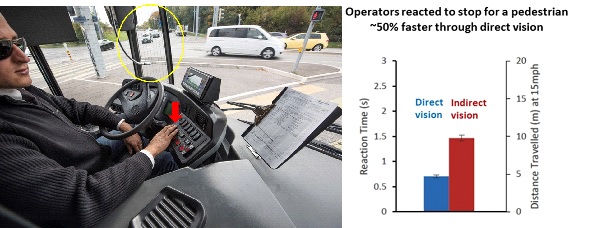News
Bus of the Future presentation to AC Transit Joint Committee
Posted October 2021

European design where the solid pillar is replaced
by glass which greatly increases visibility.
On October 14th, the joint safety committee of ATU Local 192 and AC Transit participated in a lively discussion on what a better transit bus might look like. This event was part of a project the Federal Transit Administration has labeled the Bus Compartment Redesign effort.
The International Transportation Learning Center (ITLC), FTA’s grant recipient, and its partners in this effort, call this work the design of the Bus of the Future.
ITLC Executive Director Jack Clark introduced the meeting and the project team.
In the earliest stages of this work, ITLC engaged RLS Associates, a woman-owned business with deep transit experience, to assist with project management. Christy Campoll of RLS facilitated the October 14 meeting. Styl&Tech, an engineering firm in Quebec, leads the technical work which will lead to a blueprint for an improved bus design. AC Transit donated an old Van Hool bus which is serving as the prototype for the redesign. Roch Champagne and Maxim Lambert from Styl&Tech shared major design elements from the group.
ATU International made this project happen, and ATU’s leading safety expert, Brian Sherlock worked for decades to force attention to major issues in current American bus structures. For the October 14 meeting, Brian set the tone of the discussion with a brief history of what led us to this work. He focused on his early experience as a bus operator in Seattle. Colleagues faced discipline and even criminal liability for pedestrian deaths when they knew that there was no possibility that the operator could have seen the pedestrian because of structural blind spots. Brian also recalled a friend and colleague who was murdered while driving his bus. Again, better design could have saved a life.
After the technical presentation by Styl&Tech, Christy posed a series of questions to the group to stimulate discussion. Brian offered additional technical background to inform that discussion. Approximately two hours of dialogue and debate followed in which drivers, mechanics and frontline supervisors voiced their opinions. While there was nearly unanimous approval of an operator work area that closes completely, some expressed concern that such a design might inhibit communication between passengers and operators. For all the potential problems with customer interaction, operators value that communication. One design would have wheel chair access at the middle door in a three-door bus. A number of operators said that they favored front door boarding. Similar discussions explored cameras enhancing or even replacing mirrors for a better view of the sides and rear of the bus.
Michael Flocchini, Training and Education Manager for operations and maintenance at AC Transit, wanted this meeting to take place. Now that it has, Michael and the other members of the joint committee want more: “Engaging front-line workers as the subject matter experts in the design process ensures that the bus of the future will in fact provide a safe, comfortable and reliable transit experience for all.”
For more information on the Bus of the Future project, please contact Jack Clark at jclark@transportcenter.org
